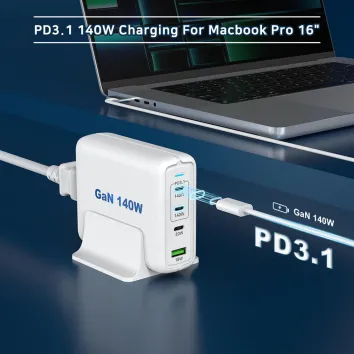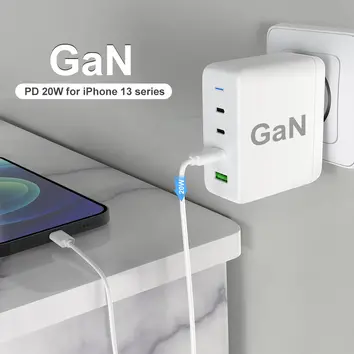Unpacking PD 3.1: Insights into the Full Industry Chain
In 1994, Intel and Microsoft initiated the International Standardization Organization, referred to as "USB-IF". This organization has developed a series of specifications and specifications for the Universal Serial Bus. These specifications are the famous USB PD protocol. In addition, they also formulated an adapted standard interface based on this specification, which is the USB interface.
Today, USB PD is one of the most versatile and influential public fast charging protocols in the world. After several version changes, USB PD updated the PD 3.1 version on May 25, 2021. Although it has only taken two years, with the widespread popularity of PD 3.1, a mature and complete product ecosystem has been built. This article will focus on the technology, products and companies of PD 3.1 to show readers its unique industry ecology.
USB PD protocol development history
USB Power Delivery (abbreviation: USB PD) is a USB charging standard technology released by USB-IF on July 5, 2012.
However, it is not the earliest USB charging standard. The USB PD specification was first born out of the first charging protocol USB BC 1.2 launched in 2010.
In the following ten years, both the number and technology of charging gears and the charging power have been significantly improved. The following is the development history of the USB PD protocol.
| Time | Protocol standards | Interface | Charging specifications |
|---|---|---|---|
| 2010 | USB BC1.2 | USB Type-A | 5V 1.5A |
| 2012.7 | USB PD1.0 | USB Type-A, USB Type-B | Unknown |
| 2014.8 | USB PD2.0 | USB Type-C | 5V 3A, 9V 3A, 15V 3A, 20V 2.25A, 20V 3A, 20V 5A |
| 2015.11 | USB PD3.0 | USB Type-C | 5V 3A, 9V 3A, 15V 3A, 20V 2.25A, 20V 3A, 20V 5A |
| 2017.2 | USB PD3.0 PPS | USB Type-C | 5V 3A, 9V 3A, 15V 3A, 20V 2.25A, 20V 3A, 20V 5A PPS: 3.3-5.9V 3A, 3.3-11V 3A, 3.3-16V 3A, 3.3-21V 3A, 33-21V 5A |
| 2021.5 | USB PD3.1 | USB Type-C | 5V 3A, 9V 3A, 15V 3A, 20V 3A, 20V 5A PPS: 3.3-5.9V 3A, 3.3-11V 3A, 3.3-16V 3A, 3.3-21V 3A, 33-21V 5A EPR: 28V 5A, 36V 5A, 48V 5A AVS: 15-28V 5A, 15-36V 5A, 15-48V 5A |
In May 2021, USB PD crossed the 100W fast charging threshold, and USB PD 3.1 was released. The protocol is divided into two parts, one is the standard power range (Standard Power Range, SPR), and the other is the extended power range (Extended Power Range, EPR). ). In fact, SPR is actually the main part of the previous version of USB PD 3.0 protocol, which means that the maximum charging power of this part is still 100W; the additional EPR is based on this standard working range, greatly increasing the maximum power of fast charging. Expanded to 240W.
Various types of fast charging products currently used in USB PD 3.1 have developed rapidly and constructed a unique "PD 3.1 product ecosystem", which is an industry feature that has emerged in the field of digital fast charging in recent years.
The product ecology of PD 3.1 originated from chip products that adapt to the PD 3.1 standard. Many chip manufacturers have developed USB-IF certified chips (protocol chips, E-marker chips), and then manufacturers of fast charging and 3C digital products will The chips are installed on their respective products and introduced to the market. In this PD 3.1 product circle, due to the unification of PD 3.1 technical standards, all links in the industrial chain can perform their respective duties and adapt to each other. Ultimately forming a very distinctive “PD 3.1 product ecology”
Next, ZONSAN will unveil the “coat of PD 3.1 product ecology” for everyone. We will first introduce the representative products of PD 3.1 in detail (laptops, chargers), and then introduce PD 3.1 chips (protocol chips, E-marker chips) and manufacturers. Finally, learn about the well-known listed companies in the upstream of this product chain.
PD3.1 laptop
Among the 3C products that support PD 3.1 fast charging, there are fewer types of laptops. Currently, only some Apple laptops support PD 3.1 fast charging.
AppleApple
MacBook Pro 16 2023 model
The sequel MacBook Pro 16 2023 model continues the good story of the 2021 model. The Apple M2 Pro or Apple M2 Max chip equipped in the notebook has been greatly improved compared to the 2021 model. It has more cores and a more powerful graphics processor. All Pro.
PD3.1 charger
Charging accessories for digital 3C products are the mainstay of the PD 3.1 product ecosystem. The current PD 3.1 fast charging technology based on the USB Type-C port still has certain difficulties, and the demand advantage of charging products above 140W in the market is not too obvious. Therefore, there are not too many manufacturers currently developing PD 3.1 charging accessories.
In the field of chargers, ZONSAN is an advanced PD3.1 fast charging manufacturer with 15 years of manufacturing experience. ZONSAN has a variety of P3.1 chargers and supports OEM/ODM, which is very suitable for providing one-stop manufacturing services to major brands.

Read More

Read More
PD3.1 fast charging protocol chip
The protocol chip is crucial to the USB PD3.1 fast charging charger. It has been a long time since the release of the USB PD3.1 fast charging standard and the launch of Apple's 140W gallium nitride fast charging. According to incomplete statistics from ZONSAN, During this period, manufacturers such as Chipsea, Hynetek, Infineon, INJOINIC, iSmartWare, JADARD, Leadtrend, Legendary, MERCHIP, Southchip, Unicmicro, Weltrend and other manufacturers have launched USB PD3.1 EPR protocol chips.
| Type | Brand | Model | Package Type |
|---|---|---|---|
| AHB controller | Chipsea | CS32G020 | QFN24 or QFN32 |
| Chipsea | CS32G051 | QFN32 | |
| AHB controller | Hynetek | HUSB251 | QFN4X4-24L |
| Hynetek | HUSB362 | S0P-14L or QFN4x4-16L or QFN4X4-24L | |
| AHB controller | Infineon | CYPD3135 | 40-QFN or 32-QFN |
| Infineon | PMG1-S3 | QFN-48 or BGA-97 | |
| Infineon | CYPD3171 | QFN24 | |
| AHB controller | INJOINIC | IP2736 | QFN24 |
| INJOINIC | IP2738 | QFN32 | |
| INJOINIC | IP2756 | QFN24 | |
| AHB controller | iSmartWare | SW2335 | QFN-20 |
| iSmartWare | SW2505 | QFN-28 | |
| iSmartWare | SW3566H | QFN4X4-32 | |
| AHB controller | JADARD | JD6628 | TQFN-32L or TQFN-40L |
| Leadtrend | LD6617 | QFN16 | |
| AHB controller | Legendary | LDR6020 | QFN-32 4x4 |
| MERCHIP | M12269 | QFN-48 | |
| MERCHIP | M12339 | QFN-48 | |
| MERCHIP | M12349 | QFN-48 | |
| AHB controller | MERCHIP | M12359 | QFN-48 |
| AHB controller | Southchip | SC9712 | QFN32 |
| AHB controller | Unicmicro | UM3506 | QFN32 |
| AHB controller | Weltrend | WT6676F | QFN-16 |
ZONSAN Summary
This report conducts an in-depth study of USB Power Delivery 3.1 (USB PD 3.1) technology and products, hoping to present readers with a more comprehensive and three-dimensional ecological outlook of PD 3.1, and summarizes the following key points:
Market growth trends
The USB PD 3.1 standard currently has a tendency to become the mainstream choice for charging and connecting electronic devices. Although the vast majority of electronic devices are still charged and connected using PD 3.0, the number of PD 3.1 products on the market is increasing significantly.
This is due to the increasing market demand for fast, efficient, and versatile charging and connectivity solutions, a trend that will continue to drive the market growth of USB PD 3.1. The market size is expected to maintain steady growth over the next five years. Based on the current situation, we hope that more PD 3.1 car chargers and laptop computers will appear in the market in the future to enrich the market categories.
Skill improved
The USB PD 3.1 standard introduces higher power transmission capabilities and supports charging power up to 240W. The significant increase in charging power means that charging devices will face higher voltages and currents. This puts forward higher technical requirements, and safety performance will also face higher challenges.
However, for now, the power of charging products that support the PD 3.1 fast charging protocol is basically 140W, which is still far from the upper power limit of 240W. But this power is enough for most electronic devices. Regardless, PD 3.1 fast charging technology provides more flexibility and performance for charging devices. This technological advancement is critical for fast charging of laptops, smartphones, tablets and other mobile devices.
Compatibility and interoperability
The popularity of the USB PD 3.1 standard has prompted the development of more devices and accessories, but compatibility and interoperability remain an important issue. At present, the USB-IF Association has formulated a unified standard. All PD 3.1 products must be certified by it and then published on the official website. The certification process is still being continuously improved and standardized. The subsequent development of unified testing and certification standards will help Solve this problem and improve user experience.
Sustainability and innovation
The high-efficiency capabilities of the USB PD 3.1 standard help reduce energy waste and reduce carbon emissions. More companies and consumers are integrating sustainability considerations into purchasing decisions, making the USB PD 3.1 standard a strong choice in an increasingly environmentally conscious market.
All in all, the USB PD 3.1 standard still has great potential in the field of charging and connecting electronic devices. It is driving electronic device market growth, fast charging technology advancements and energy sustainability, but on the other hand it still faces challenges. Issues of compatibility and interoperability need to be addressed first, which requires industry parties to work closely together to develop standards and resolve issues. Secondly, it is necessary to increase R&D and investment in technology and continue to bravely climb towards the power limit of PD 3.1. Finally, we hope to further enrich the different product categories of PD3.1, such as laptops, car chargers, outdoor power supplies and other different product categories.